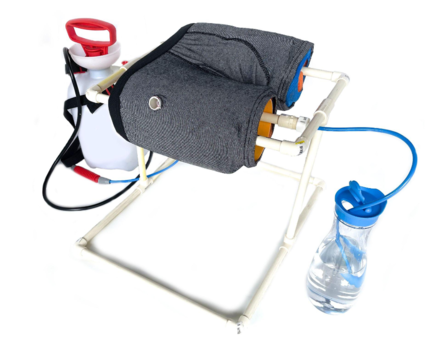We introduce the second generation of CrashSavers DIY Simulators: Pressure and Foley.
This CrashSavers module will allow first responders to become confident and competent in performing foley catheter balloon tamponade as part of a toolkit of hemorrhage control techniques performed in rural and/or LMIC prehospital settings.
Why Foley?[edit | edit source]
Foley catheters can be helpful when a patient’s bleeding originates from narrow, deep wounds or at sites such as the neck or groin where it is impossible to apply a tourniquet. If one catheter is insufficient, additional catheters can be used to increase the amount of compression delivered by the inflated balloons. CrashSavers has chosen the Foley Hemostatic technique because Foley catheters are easy to find, easy to use, and helpful in wounds that are difficult to manage with other hemostasis techniques. By teaching this technique to prehospital personnel, it is more likely that better hemorrhage control will be achieved from the beginning of trauma management, improving the life expectancy of patients arriving at hospital emergency rooms.
The CrashSavers Foley Simulator and VR app are designed to work together, allowing providers to become confident and competent in performing foley catheter application and compression for hemorrhage control performed for actively bleeding individuals.
When a foley catheter is identified as an appropriate choice in the clinical case scenario within the VR app, learners can then use the Foley Simulator to practice their skills until they become proficient in this technique. If learners fail to identify the foley catheter as the best option in a clinical case scenario, the VR app will provide relevant educational content and feedback to the learner. With the Foley Simulator, learners create a replica of a penetrating wound in an extremity. The simulated injury is deep and requires quick pressure to achieve hemostasis. The CrashSavers Foley module will train learners to insert a foley catheter into the wound and inflate the balloon to obtain hemorrhage control.
Construction Manual[edit | edit source]
The following Construction Manual guides learners through building our simple, fast, and cheap simulator for foley compression. After the simulator model has been built, learners can continue through the clinical case scenarios within the CrashSavers VR app to practice application of hemorrhage control techniques. In the Construction Manual, learners will find all relevant materials on pricing, online providers, and step-by-step instructions for building the simulator.
Construction Logistics[edit | edit source]
Building Time and Costs[edit | edit source]
All materials needed to create the simulator were chosen for their ready availability worldwide. Everything is easy to find at local stores in Guatemala, and many have also been listed in online stores. To the best of our knowledge, there is not a comparable physical model for training hemorrhage control techniques that provides as comprehensive of an educational experience at this price.
| Time | 45 - 90 minutes |
| Costs | ~$45.55 |
Reproducibility[edit | edit source]
Our team is conscious and mindful of the need for ease and reproducibility of our simulator model in order for it to be appropriately used by learners of different abilities and experiences. We addressed this by piloting the simulator model with 2 different groups–engineers who devised the simulator, and firefighter trainees. The firefighter trainees were instructed to construct the simulator without any assistance. They reported that assembling the simulator was straightforward, despite not having any engineering background, experience, or expertise. The firefighters were able to complete the simulator construction in 1.5 hours.

